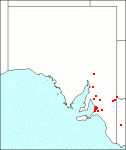|
Setaria pumila
Citation:
Schultes in Schultes & Schultes f., Manl. 2:274 (1824) subsp, pumila.
Synonymy: Panicum pumilum Poiret, Encycl. Suppl. 4:273 (1816); S. glauca sensu Jessop in J. Black, Fl. S. Aust. 232 (1978), non (L.)P. Beauv.
Common name: Pale pigeon-grass.
Description:
Erect pale-green annual, to 1 m high; leaf blades flat, 3-7 mm broad, with scabrous edges; ligule of hairs and sometimes also long hairs near the base of the leaf sheath.
Panicle spike-like, dense, 2-8 cm long, 5-8 mm broad (excluding the bristles); spikelets ovoid, 2.5-3 mm long; bristles yellow or reddish-yellow, c. 6 mm long, denticulate with erect teeth, 6-8 at the base of each spikelet; first glume about half as long as the spikelet, second glume only slightly longer than the first and exposing the fertile lemma; first lemma and its enclosed palea as long as the spikelet, second (fertile) lemma transversely and coarsely wrinkled.
Published illustration:
Burbidge (1968) Australian grasses 2:pl. 47; Cunningham et al. (1982) Plants of western New South Wales, p. 138.
|
|
Distribution:
|
A weed of disturbed ground.
All mainland States except the N.T. Native to Europe, Asia and northern Australia.
|
Conservation status:
naturalised
Flowering time: Feb. — May.
|

SA Distribution Map based
on current data relating to
specimens held in the
State Herbarium of South Australia
|
Biology:
No text
Author:
Not yet available
|

